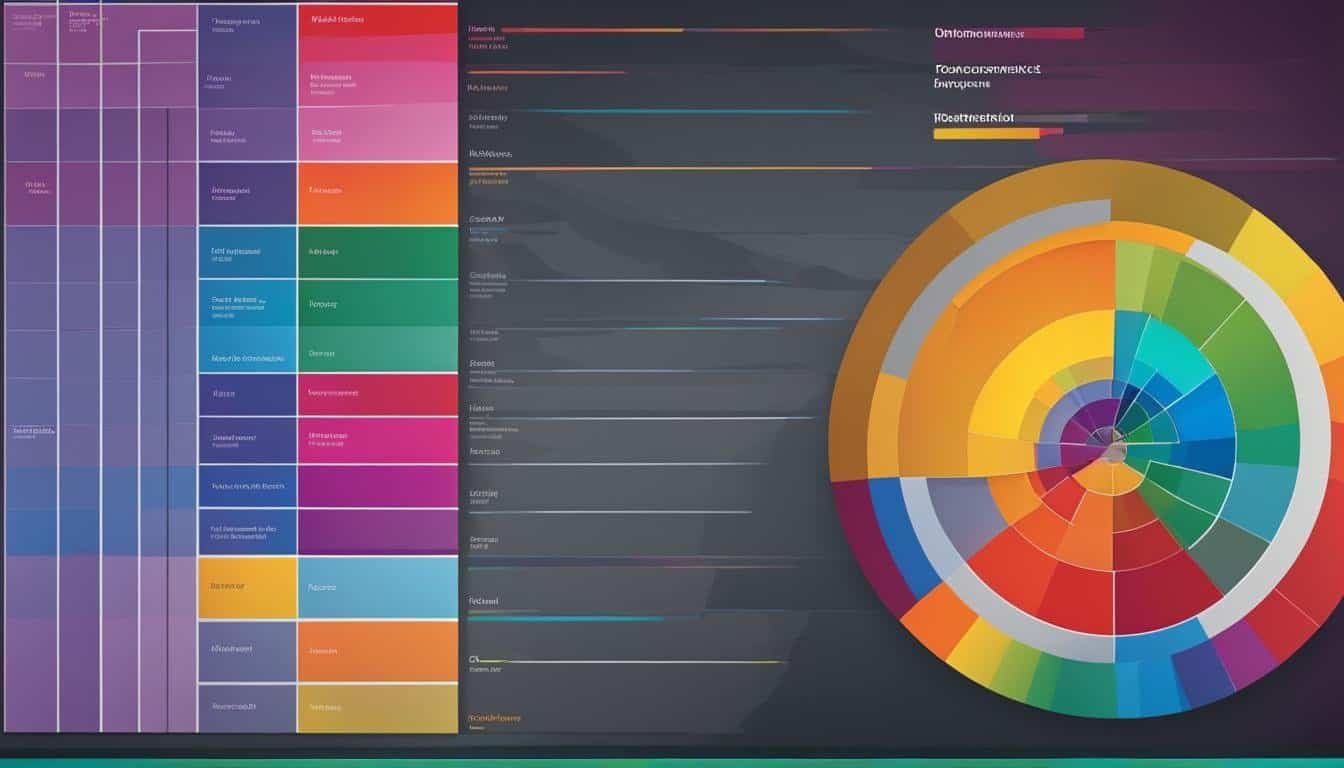Dominance DISC Profile: Understanding Its Role in Behavior and Leadership
Welcome to our insightful exploration of the Dominance DISC profile. In this article, we will delve into the fascinating world of dominant behavior and how it relates to behavior and leadership dynamics. By understanding the intricacies of the Dominance DISC profile, we can gain valuable insights into assertiveness, power dynamics, and social dominance.
Key Takeaways:
- The Dominance DISC profile is characterized by individuals who value shaping the environment, overcoming opposition, and achieving results.
- Dominant leaders exhibit commanding and resolute traits, striving for unique accomplishments and maintaining control.
- Understanding the Dominance DISC profile can lead to effective leadership and enhanced teamwork.
- The D style in DISC profiles prioritizes individual goals such as striving for unique accomplishments and exploring new opportunities.
- Individuals with the D style may struggle with patience, sensitivity, explaining details, and allowing for deliberation.
The D Style: Traits and Goals
In DISC profiles, the D style represents individuals with dominant traits and a strong drive for achievement. They prioritize personal goals that involve striving for unique accomplishments, exploring new opportunities, and maintaining control. D-style individuals are characterized by their assertiveness, confidence, and determination.
The D style is known for its dominant traits and an unwavering focus on success. These individuals possess a natural inclination towards taking charge and leading others. They value setting ambitious goals and pursuing them with passion and zeal. D-style individuals are often seen as proactive and self-motivated, always seeking new challenges and situations to excel in.
One of the key goals of individuals with the D style is to achieve unique accomplishments. They thrive on being recognized for their achievements and strive to stand out from the crowd. Whether it’s in their personal or professional lives, D-style individuals are driven by the desire to leave a lasting impact and make a difference.
“The D style is all about embracing new opportunities and pushing boundaries. It’s about taking risks, being bold, and embracing the unknown.”
Exploring new opportunities is another significant goal for those with the D style. They are naturally curious and eager to try new things. D-style individuals see possibilities where others may see obstacles, and they are not afraid to step outside their comfort zones to seize new opportunities for growth and success.
Furthermore, maintaining control is crucial for individuals with the D style. They thrive in leadership positions and enjoy being in positions of authority. D-style individuals are adept at making decisions and taking charge, as they possess a natural ability to navigate complex situations and influence others.
Adopting a D style can open up a world of new possibilities and opportunities for personal and professional growth. By harnessing their dominant traits and focusing on their goals, individuals with the D style can achieve unique accomplishments and make a significant impact in their chosen fields.
The image above represents the energy and determination associated with the D style, encapsulating their drive for success and their thirst for new opportunities.
Challenges Faced by D Styles
While individuals with the D style exhibit strong traits and goals, they may encounter certain challenges in their interactions and communication. Patience, sensitivity, explaining details, and allowing for deliberation are some of the areas where D styles may struggle.
1. Patience
Patience is not typically a strong suit for those with the D style. Their inherent drive for results and accomplishments often leads them to be action-oriented, causing impatience in situations that require a more measured approach. This can sometimes hinder their ability to collaborate with others effectively.
2. Sensitivity
D styles tend to prioritize assertiveness and directness, sometimes at the expense of sensitivity. Their blunt communication style and focus on achieving goals can unintentionally come across as insensitive or dismissive to others. Building rapport and maintaining harmonious relationships may require conscious effort from D styles.
3. Explaining Details
Due to their preference for big-picture thinking and quick decision-making, individuals with the D style may struggle with providing thorough explanations of details. They prioritize efficiency and results, often assuming that others will just “get it.” This can lead to misunderstandings or frustrations in team settings where clarity is essential.
4. Allowing for Deliberation
D styles are known for their decisive nature and a preference for moving quickly. However, this can sometimes result in overlooking the importance of allowing others to deliberate and share their perspectives. In collaborative environments, it is crucial for D styles to recognize the value of input from others and create space for deliberation and consensus-building.
“The ability to exhibit patience, sensitivity, and effective communication is essential for D styles to navigate challenges and build strong relationships.”
Understanding these challenges can help individuals with the D style develop greater self-awareness and adapt their behaviors to enhance collaboration and communication with others. By recognizing the importance of patience, sensitivity, explaining details, and allowing for deliberation, D styles can unlock their full potential and become more effective leaders and team members.
The D Style in Leadership
Leaders with the D style in DISC profiles possess a commanding presence, demonstrating resolute decision-making and pioneering spirit. Their confidence and unwavering focus drive them to achieve exceptional results in their teams and organizations.
These leaders exhibit a commanding nature, asserting their authority and leading with a strong sense of purpose. They are not afraid to take charge, make bold decisions, and guide their teams towards success.
The resolute nature of D-style leaders enables them to stay determined and steadfast in the face of challenges. They have a clear vision and are committed to achieving their goals, inspiring their team members to follow suit.
Furthermore, D-style leaders demonstrate pioneering qualities, constantly seeking new opportunities and pushing boundaries. They are not content with the status quo and are willing to explore uncharted territories to drive innovation and growth.
“A true leader has the confidence to stand alone, the courage to make tough decisions, and the compassion to listen to the needs of others. He does not set out to be a leader, but becomes one by the quality of his actions and the integrity of his intent.” – Douglas MacArthur
With their commanding, resolute, and pioneering attributes, D-style leaders inspire their teams to deliver exceptional performance. They create an environment that fosters growth, encourages initiative, and empowers individuals to take risks and achieve remarkable outcomes.
| Commanding | Resolute | Pioneering |
|---|---|---|
| Exercises authority and control | Determined and unwavering | Explores new opportunities |
| Guides and directs team members | Committed to goals and objectives | Pursues innovation and growth |
| Sets high standards and expectations | Overcomes obstacles with fortitude | Takes calculated risks |
Understanding the Di Style
The Di style in DISC profiles is results-oriented, vocal, and enthusiastic. These individuals influence others through charm and bold action.
Di styles are driven by their desire for tangible outcomes and are known for their ability to achieve results. They have a strong focus on accomplishing their goals and are motivated by the satisfaction of seeing their efforts come to fruition.
The Di style is characterized by their vocal nature. They are not afraid to speak up and share their ideas, opinions, and perspectives. Their expressive communication style enables them to effectively convey their thoughts and influence those around them.
Enthusiasm is a hallmark trait of Di styles. They approach tasks and challenges with energy and excitement, inspiring those around them to join in their enthusiasm. Their positive attitude and passion can ignite a spark in others and create a dynamic and engaging work environment.
Di styles have the ability to rally a team, encourage collaboration, and generate excitement about projects. Their enthusiastic approach can be infectious and help motivate others to go above and beyond their limits.
The Power of Vocal Leadership
Di styles thrive in leadership positions where they can utilize their results-oriented mindset, vocal nature, and enthusiasm to drive their teams towards success. Their ability to clearly communicate goals, express expectations, and inspire others makes them effective leaders.
Leading with charm and charisma, Di styles can inspire their team members and create a positive and motivated work environment. Their vocal leadership style allows them to effectively convey their vision, address challenges, and motivate their team to achieve exceptional results.
| Di Style Strengths | Di Style Weaknesses |
|---|---|
| Results-oriented mindset | May overlook details |
| Effective communication | Can be overly assertive |
| Charismatic leadership | May prioritize achievement over relationships |
| Ability to inspire others | Risk of burning out due to high energy levels |
Overall, the Di style brings a dynamic and energetic approach to leadership. Their results-oriented mindset, vocal nature, and enthusiasm make them powerful influencers, capable of driving their teams towards success.
Exploring the DC Style
The DC style in DISC profiles embodies individuals who possess a unique blend of diligence, tough-mindedness, and creativity. These individuals influence others through their high standards, unwavering determination, and innovative thinking.
With their diligent nature, individuals with the DC style approach tasks and challenges with meticulous attention to detail and a steadfast commitment to excellence. They tirelessly strive to achieve their goals, leaving no stone unturned in their pursuit of success. Their dedication and strong work ethic set them apart, making them valuable assets in any team or organization.
“Diligence is the mother of good fortune.” – Miguel de Cervantes
In addition to their diligence, individuals with the DC style possess a tough-mindedness that allows them to navigate obstacles and setbacks with resilience and determination. They possess a strong mental fortitude and an unwavering commitment to their beliefs and values. This tough-mindedness enables them to stay focused on their goals, even in the face of challenges and adversity.
Furthermore, the DC style is characterized by a creative approach to problem-solving and innovation. These individuals possess a natural ability to think outside the box and generate unique solutions to complex problems. Their creative mindset allows them to envision new possibilities and explore unconventional strategies, leading to fresh insights and breakthrough achievements.
Benefits of the DC Style:
- Highly diligent and detail-oriented
- Tough-minded and resilient
- Creative and innovative
- Unwavering commitment to excellence
Quotable Insights:
“Success is no accident. It is hard work, perseverance, learning, studying, sacrifice, and most of all, love of what you are doing or learning to do.” – Pelé
The DC style is a powerful force in any team or organization, bringing the qualities of diligence, toughness, and creativity to the table. By harnessing these traits, individuals with the DC style inspire and motivate others to push boundaries, embrace challenges, and achieve outstanding results.
Strengths and Weaknesses of D Styles
D styles, characterized by direct, decisive, and results-oriented behavior, possess several strengths that contribute to their effectiveness in various domains. Their ability to take charge, make quick decisions, and drive outcomes propels them towards achieving their goals. D styles excel in leadership positions where their commanding presence and resolute nature inspire others to action. Their determination and focus on results make them valuable assets in high-pressure environments.
However, these strengths can sometimes manifest as weaknesses, leading to potential challenges. D styles have a tendency to overstep authority, inadvertently disregarding the boundaries of their role. This overstepping of authority can lead to strained relationships and conflicts within teams and organizations. Additionally, their assertive and direct communication style may come across as argumentative, making it difficult for them to build rapport and collaborate effectively. Their preference for action may cause them to overlook important details, potentially leading to critical mistakes or subpar results.
Despite these challenges, D styles can maximize their strengths and overcome their weaknesses by adopting a more collaborative approach, actively listening to others, and allowing space for diverse perspectives. Recognizing the importance of teamwork, effective delegation, and considering the ideas and contributions of others fosters a more inclusive and successful work environment. By being receptive to feedback and consciously working on communication skills, D styles can enhance their effectiveness in leading and collaborating with others.
| Strengths of D Styles | Weaknesses of D Styles |
|---|---|
|
|
Overall, understanding the strengths and weaknesses of D styles is crucial for personal development and effective leadership. By leveraging their strengths while addressing their weaknesses, D styles can enhance their leadership capabilities and foster collaborative and successful team dynamics.
Motivations and Fears of D Styles
The D styles in DISC profiles are driven by specific motivations and harbor unique fears. Understanding these motivations and fears is essential for comprehending their behavior and creating an environment that supports their growth and development.
Motivations of D Styles
Individuals with the D style are highly motivated by various factors that align with their dominant nature. Some of the key motivations of D styles include:
- Challenges: D styles thrive on challenges and enjoy pushing themselves to overcome obstacles and achieve their goals.
- Goal Achievement: They are motivated by setting and accomplishing goals, as they have a strong desire to succeed and make a tangible impact.
- Tangible Results: D styles appreciate the satisfaction that comes from producing concrete and measurable outcomes. They are driven by the need to see tangible results.
- Recognition: Being recognized for their achievements and contributions is another significant motivator for D styles. They appreciate acknowledgment for their hard work and accomplishments.
These motivations drive D styles to take charge, seek out new opportunities, and strive for success in various aspects of their lives.
Fears of D Styles
Despite their dominant nature, D styles also harbor fears that may impact their behavior and decision-making. Some common fears of D styles include:
- Being Taken Advantage Of: D styles fear being taken advantage of by others, as they value control and prefer to be in charge of their own destiny.
- Losing Control: D styles have a strong need for control and fear situations where they feel like they’re losing control or being restricted.
- Lack of Tangible Results: They fear not achieving their desired outcomes or seeing concrete results from their efforts.
- Lack of Visibility: D styles value being seen and heard, so they may fear situations where their contributions or expertise go unnoticed or underappreciated.
These fears can influence the behavior of D styles and may lead them to assert their dominance, seek control, or strive for visibility in order to mitigate these anxieties.
The image above illustrates the fears and motivations of D styles, providing a visual representation of their internal drives and concerns. Understanding these fears and motivations is essential for creating an environment that supports D styles and allows them to thrive.
Conclusion
In conclusion, dominance plays a significant role in DISC profiles, shaping behavior in leadership and team dynamics. Understanding the strengths, motivations, and challenges of individuals with the D style can lead to effective leadership and enhanced teamwork.
Dominance in relationships is a key aspect influenced by the D style, where individuals with dominant traits tend to assert themselves and prioritize their goals. This dominance hierarchy can impact power dynamics within teams and organizations.
Additionally, dominance psychology comes into play as D-style leaders exhibit commanding and resolute traits, driving them to achieve unique accomplishments and explore new opportunities. However, challenges such as patience, sensitivity, and explaining details may arise for individuals with this style.
By understanding the complexities of dominance in relationships, dominance hierarchy, and dominance psychology, leaders can effectively leverage the strengths of the D style while addressing the associated challenges. This knowledge fosters a conducive environment for collaboration, allowing diverse personalities to thrive and contribute to the overall success of the team.






